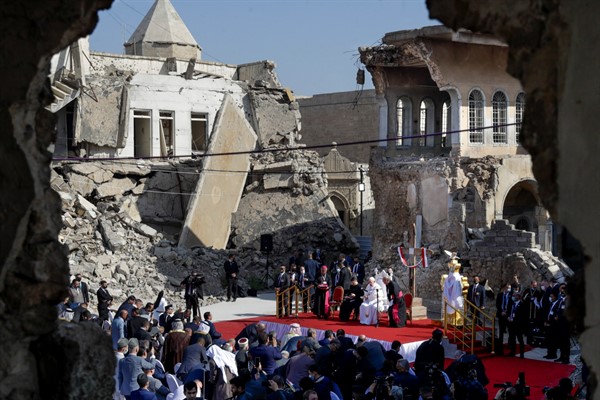Editor’s Note: Every Monday, Managing Editor Frederick Deknatel highlights a major unfolding story in the Middle East, while curating some of the best news and analysis from the region. Subscribers can adjust their newsletter settings to receive Middle East Memo by email every week.
“Mosul Welcomes You,” read banners across the city when Pope Francis visited Sunday, the last full day of his landmark trip to Iraq. Most of the banners covered crumbling buildings or hung on walls still pockmarked by bullets and artillery. The pope arrived in Mosul by helicopter, flying over the “the rubble of houses [that] stretched out like a vast quarry,” as The New York Times’ Jason Horowitz and Jane Arraf reported from what used to be Iraq’s second-largest city.
Pope Francis later rode in a golf cart to what is left of the Syriac Catholic al-Tahera Church, in the heart of the hugely damaged Old City, on the west bank of the Tigris River. The Islamic State had used the church as a makeshift courthouse after it overran Mosul in 2014. When U.S.-backed Iraqi forces finally retook the city in 2017, the al-Tahera Church, like other churches, mosques and shrines around it in the Old City, was in ruins. The Islamic State had destroyed many of them deliberately, including Mosul’s main landmark, the medieval Great Mosque of al-Nuri, with its signature tilting minaret, known locally as “al-Hadba,” or the hunchback. The Islamic State’s leader, Abu Bakr al-Baghdadi, had declared his “caliphate” from the mosque’s minbar in 2014, in a choreographed attempt at Islamic legitimacy; in 2017, the extremists blew the mosque up as U.S. and Iraqi forces closed in.

